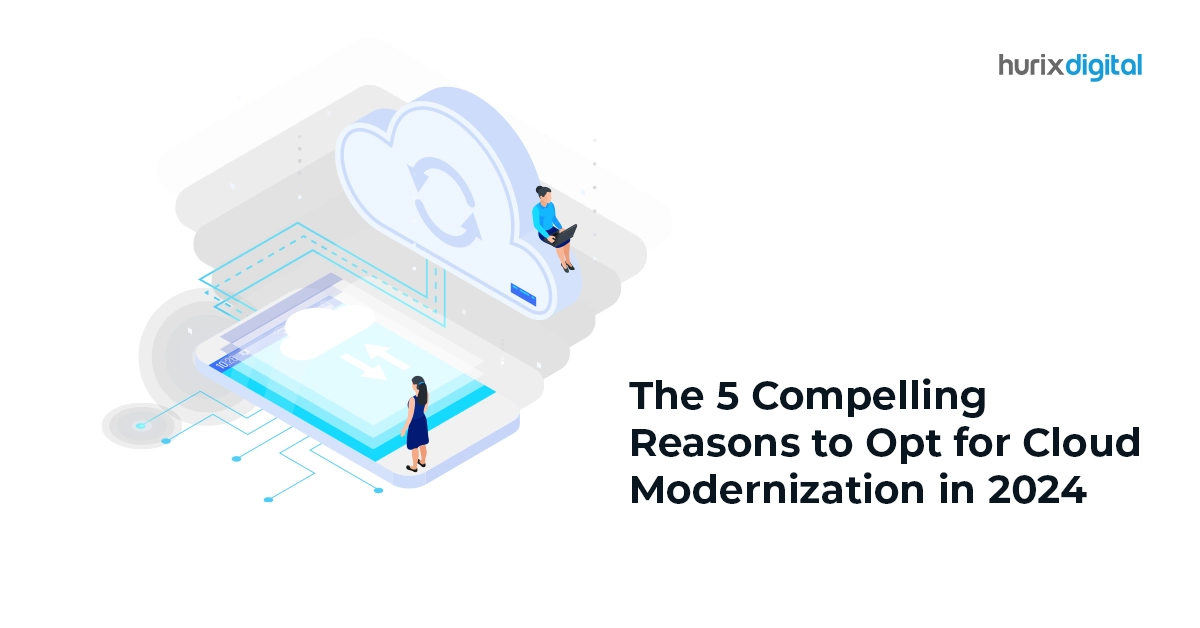
The 5 Compelling Reasons to Opt for Cloud Modernization in 2024
Summary
Learn why cloud modernization is essential in 2024. This blog outlines five key reasons to adopt cloud solutions for enhanced efficiency and scalability.
The digital age is fraught with complexities. To navigate through it seamlessly, it is imperative to drive efficiency and innovation in IT strategies and technologies. Cloud computing is a key component of IT, and businesses’ reliance on it is growing. This is highlighted by Gartner’s report, which projects an increase of $678.8 billion in spending on public cloud by end-users in 2024.
Consequently, more organizational workload will be hosted on cloud platforms this year. Hence, focus has to be diverted compulsorily on cloud modernization to ensure optimum security of applications, enhanced resilience, and top-notch scalability. This post focuses on the key drivers to embrace the modernization of the cloud in 2024.
Table of Contents:
Important Strategic Drivers For Green Signaling Cloud Modernization in 2024
Informatica, a renowned analytics report provider, recently surveyed the industry’s top data leaders and published the findings in its ‘State of Cloud Modernization Report 2024‘. The majority of respondents concurred that cloud modernization will be compulsory in 2024 for thriving in the Artificial Intelligence (AI) era.
Almost 56% of leaders have already recommended that their organizations’ executive boards undertake modernization to improve efficiency, drive innovation, and usher in better scalability in cloud computing. Companies that are still indecisive can suffer from poor agility and an impaired ability to integrate with cloud-native platforms.
The broad reasons for undertaking cloud modernization in 2024 are discussed below for reference.
1. Staying Innovative and Competitive
Businesses that wish to retain their competitive edge in 2024 with more out-of-the-box IT-underpinned technological interventions need to embrace digital transformation with the cloud.
This will facilitate the streamlined adoption of cutting-edge technologies, such as Artificial Intelligence (AI), Machine Learning (ML), 5G, edge computing, advanced data analytics, etc. Further, cloud computing capabilities can be adequately upgraded only when modernized elements are incorporated into existing infrastructure.
Upgraded cloud architecture will empower businesses in:
- Optimizing critical operations
- Improving customer experiences
- Generating incisive insights into targeted niches and expertise areas
- Developing new services and products
- Taking data governance and maturity to the next level
- Promoting sustainability practices
The best modernization strategy will depend on the outcomes of the IT landscape assessment and business objectives’ evaluation in alignment with the long-term growth outlook.
Also Read: 5 Biggest Myths Surrounding Cloud Computing & Services, Debunked!
2. Enhancing Cloud Security
In 2024, more businesses will migrate to the cloud. This necessitates modernizing the cloud for existing businesses so that they can benefit from stricter security standards like SOC 2, HIPAA, and GDPR.
Encryption and redundant data backup methods will grow in complexity. Only modernization will ensure that cybersecurity threats are proactively thwarted and service reliability is maintained. Enhanced cloud security will pave the way for business continuity and trust-building with consumers.
In 2024, cloud modernization will facilitate businesses to:
- Gain better visibility into cloud data access by third parties and others.
- Escape from collateral damage induced by malicious attacks aimed at other hosted services using a shared cloud environment.
- Better manage access points from different geolocations and devices with stricter implementation of BYOD (Bring-Your-Own-Device) policies.
- Avoid expensive compliance issues through better data privacy-related regulatory conformance in hybrid or public cloud deployments.
- Eliminate misconfigurations, inadvertent negligent actions of administrators, and other activities that can lead to security breaches.
- Strengthen identity management, reduce system vulnerabilities, and enhance the security of APIs and interfaces.
- Reinforce real-time detection of cloud threats and institute more intuitive remediation techniques.
3. Adopting Sophisticated Business Practices
Businesses aspiring to integrate advanced practices in their cloud-based workflow must opt for modernization. This is because almost 39% of businesses rely on cloud platforms for hosting more than half of their workloads.
Also, approximately 69% of businesses seek the services of more than one cloud service provider to run their activities smoothly. Businesses rely excessively on the cloud, and cloud modernization is compulsory to integrate sophistication in their strategic planning and data-underpinned decision-making processes.
Advanced business practices need a heightened level of security. As most businesses use more than one cloud service provider, they are confronted with the challenge of implementing security policies consistently across discrete platforms by navigating their complexities. New-age cloud-based security solutions can be implemented when cloud services are modernized. This will help businesses adopt advanced practices quickly in 2024.
4. Avoiding the Risk of Becoming Obsolete
Businesses that neglect cloud automation and modernization in 2024 will face the risk of becoming obsolete. Their niche adversaries will be equipped with state-of-the-art cloud technologies, and legacy applications will not stand a chance to compete with them.
Investment in new cloud deployment models would make businesses future-ready. If businesses are still deploying monolithic and sluggish cloud applications, they need to migrate to advanced cloud architectures for more scalability, agility, cost competitiveness, and speed.
5. Maintaining a Global Presence
Businesses with global footprints need to modernize the cloud to stay a step ahead of their peers. The remote servers in different data centers continuously undergo changes, which impact the functionalities of applications running from scalable virtual machines.
If the cloud is not modernized, businesses will not be able to properly benefit from resource pooling of computing resources. Hence, utilization, scaling of infrastructure, and on-demand allocation of resources can become slower and inefficient.
Lack of modernization will hamper the effective performance of IaaS, SaaS, and PaaS-like cloud service models. It will also make cloud data management more cumbersome, denting the flexibility of hybrid, private, and public models.
All these will affect the business’s global collaboration and accessibility. Low latency in cloud networking is mandatory for seamless global connectivity, which will also suffer in the absence of scalable and secure cloud resources.
Businesses with the modernized cloud can become more operationally efficient with CDNs (Content Delivery Networks), disaster recovery configurations, and multi-region deployment.
Also Read: Maximizing Customer Experience: Key Performance Indicators for Cloud-Managed Services
Way Forward
The strategic importance of cloud modernization in 2024 cannot be overstated for businesses aspiring to scale new heights of success by optimizing resources, staying responsive to consumer needs, and becoming more cost-competitive. Modernization will help organizations unlock new value from AI, ML, and data-driven insight-providing applications. This will serve as the base for data excellence and continuous growth.
Hurix Digital prides itself on seasoned cloud professionals who leverage our state-of-the-art infrastructure to help businesses modernize their cloud applications, transition from legacy to cloud-based platforms, and enjoy formidable security in a multi-cloud environment. We empower businesses with improved flexibility, enhanced operational efficiency, quicker processes, and the ability to integrate with AI, ML, and other futuristic technologies.
Want to learn more? Connect with us to become future-ready.

Currently serving as the Vice President of Technology Delivery Operations at HurixDigital, a prominent global provider of digital content and technology solutions for publishers, corporations, and educational institutions. With over 16 years of experience spanning EdTech and various domains, I hold certification as a SCRUM Product Owner (CSPO). My expertise includes operations, finance, and adept people management skills.



